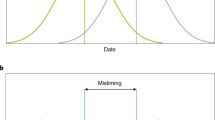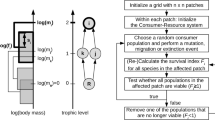Abstract
Phenology is a crucial life history trait for species interactions and it can have great repercussions on the persistence of communities and ecosystems. Changes in phenology caused by climate change can disrupt species interactions causing decreases in consumer growth rates, as suggested by the match–mismatch hypothesis (MMH). However, it is still not clear what the long-term consequences of such phenological changes are. In this paper, we present models in which phenology and consumer–resource feedbacks determine long-term community dynamics. Our results show that consumer viability is constrained by limits in the amount of phenological mismatch with their resources, in accordance with the MMH, but the effects of phenological shifts are often nonmonotonic. Consumers generally have higher abundances when they recruit some time before or after their resources because this reduces the long-term effects of overexploitation that would otherwise occur under closer synchrony. Changes in the duration of recruitment phenologies also have important impacts on community stability, with shorter phenologies promoting oscillations and cycles. For small community modules, the effects of phenological shifts on populations can be explained, to a great extent, as superpositions of their effects on consumer–resource pairs. We highlight that consumer–resource feedbacks and overexploitation, which are not typically considered in phenological models, are important factors shaping the long-term responses to phenological changes caused by climate change.




Similar content being viewed by others
References
Aberle N, Bauer B, Lewandowska A, Gaedke U, Sommer U (2012) Warming induces shifts in microzooplankton phenology and reduces time-lags between phytoplankton and protozoan production. Mar Biol 159(11):2441–2453
Abrams PA (2004) When does periodic variation in resource growth allow robust coexistence of competing consumer species? Ecology 85:372–382
Altermatt F (2009) Climatic warming increases voltinism in European butterflies and moths. Proc R Soc B Biol Sci 277(1685):1281–1287
Both C, Bouwhuis S, Lessells CM, Visser ME (2006) Climate change and population declines in a long-distance migratory bird. Nature 441(7089):81–83
Cushing DH (1990) Plankton production and year-class strength in fish populations: an update of the match/mismatch hypothesis. Adv Mar Biol 26:249–293
Donnelly A, Caffarra A, O’Neill BF (2011) A review of climate-driven mismatches between interdependent phenophases in terrestrial and aquatic ecosystems. Int J Biometeorol 55:805–817
Dunne JA, Harte J, Taylor KJ (2003) Subalpine meadow flowering phenology responses to climate change: integrating experimental and gradient methods. Ecol Monogr 73(1):69–86
Durant JM, Hjermann D, Anker-Nilssen T, Beaugrand G, Mysterud A, Pettorelli N, Stenseth NC (2005) Timing and abundance as key mechanisms affecting trophic interactions in variable environments. Ecol Lett 8(9):952–958
Durant JM, Hjermann DO, Ottersen G, Stenseth NC (2007) Climate and the match or mismatch between predator requirements and resource availability. Clim Res 33(3):271–283
Durant JM, Hjermann DO, Falkenhaug T, Gifford DJ, Naustvoll L-J, Sullivan G, Beaugrand BK, Stenseth NC (2013) Extension of the match–mismatch hypothesis to predator-controlled systems. Mar Ecol Prog Ser 474:43–52
Ebenhöh W (1992) Temporal organization in a multi-species model. Theor Popul Biol 42:152–171
Encinas-Viso F, Revilla TA, Etienne RS (2012) Phenology drives mutualistic network structure and diversity. Ecol Lett 15(3):198–208
Fleming TH, Partridge BL (1984) On the analysis of phenological overlap. Oecologia 62(3):344–350
Gause GF (1934) The struggle for existence. Williams & Wilkins, Baltimore, MD
Gilman RT, Fabina NS, Abbott KC, Rafferty NE (2012) Evolution of plant-pollinator mutualisms in response to climate change. Evol Appl 5(1):2–16
Hastings A, Powell T (1991) Chaos in a three-species food chain. Ecology 72(3):896–903
Holt RD (1997) Community modules. In: Gange AC, Brown VK (eds) 36th symposium of the British ecological society, multitrophic interactions in terrestrial ecosystems. Blackwell Science, pp 333–349
Huffaker CB (1958) Experimental studies on predation: dispersion factors and predator–prey oscillations. Hilgardia 27:795–835
Johansson J, Jonzén N (2012) Game theory sheds new light on ecological responses to current climate change when phenology is historically mismatched. Ecol Lett 15(8):881–888
Kallimanis AS, Petanidou T, Tzanopoulos J, Pantis JD, Sgardelis SP (2009) Do plant-pollinator interaction networks result from stochastic processes. Ecol Model 220:684–693
Kerby JT, Wilmers CC, Post E (2012) Climate change, phenology and the nature of consumer–resource interactions: advancing the match/mismatch hypothesis. In: Ohgushi T, Schmitz OJ, Holt RD (eds) Trait-mediated indirect interactions: ecological and evolutionary perspectives. Cambridge University Press, pp 508–525
Kristiansen T, Drinkwater KF, Lough RG, Sundby S (2011) Recruitment variability in North Atlantic cod and match–mismatch dynamics. PLoS ONE 6(3):e17456
Lawler SP, Morin PJ (1993) Temporal overlap, competition, and priority effects in larval anurans. Ecology 74(1):174–182
Loreau M (1989) Coexistence of temporally segregated competitors in a cyclic environment. Theor Popul Biol 36(2):181–201
Loreau M (1992) Time scale of resource dynamics and coexistence through time partitioning. Theor Popul Biol 41(3):401–412
Luckinbill LS (1973) Coexistence in laboratory populations of Paramecium aurelia and its predator Didinium nasutum. Ecology 54(6):1320–1327
May RM (1974) Stability and complexity in model ecosystems. Princeton landmarks in biology. Princeton University Press, Princeton
Memmott J, Craze PG, Waser NM, Price MV (2007) Global warming and the disruption of plant–pollinator interactions. Ecol Lett 10(8):710–717
Miller-Rushing AJ, Høye TT, Inouye DW, Post E (2010) The effects of phenological mismatches on demography. Phil Trans R Soc B Biol Sci 365(1555):3177–3186
Morin PJ (1987) Predation, breeding asynchrony, and the outcome of competition among treefrog tadpoles. Ecology 68(3):675– 683
Morin PJ (1999) Productivity, intraguild predation, and population dynamics in experimental food webs. Ecology 80:752–760
Murdoch WW, Briggs CJ, Nisbet RM (2003) Consumer–resource dynamics. Number 36 in monographs in population biology. Princeton University Press, Princeton
Nakazawa T, Doi H (2012) A perspective on match/mismatch of phenology in community contexts. Oikos 121(4):489–495
Namba T (1984) Competitive co-existence in a seasonally fluctuating environment. J Theor Biol 111(2):369–386
Olesen JM, Bascompte J, Dupont YL, Elberling H, Rasmussen C, Jordano P (2011) Missing and forbidden links in mutualistic networks. Proc R Soc B Biol Sci 278(1706):725–732
Ozgul A, Childs DZ, Oli MK, Armitage KB, Blumstein DT, Olson LE, Tuljapurkar S, Coulson T (2010) Coupled dynamics of body mass and population growth in response to environmental change. Nature 466(7305):482–485
Pachepsky E, Nisbet RM, Murdoch WW (2008) Between discrete and continuous: consumer–resource dynamics with synchronized reproduction. Ecology 89:280–288
Parmesan C (2006) Ecological and evolutionary responses to recent climate change. Ann Rev Ecol Evol Syst 37:637–669
Parmesan C (2007) Influences of species, latitudes and methodologies on estimates of phenological response to global warming. Glob Chang Biol 13(9):1860–1872
Parmesan C, Yohe G (2003) A globally coherent fingerprint of climate change impacts across natural systems. Nature 421(6918):37–42
Revilla TA (2000) Resource competition in stage-structured populations. J Theor Biol 204:289–298
Rivero A, Casas J (1999) Rate of nutrient allocation to egg production in a parasitic wasp. Proc R Soc Lond B 266(1424):1169–1174
Rockwell RF, Gormezano LJ, Koons DN (2011) Trophic matches and mismatches: can polar bears reduce the abundance of nesting snow geese in Western Hudson Bay. Oikos 120(5):696–709
Russell FL, Louda SM (2004) Phenological synchrony affects interaction strength of an exotic weevil with platte thistle, a native host plant. Oecologia 139(4):525–534
Salinger MJ (2005) Climate variability and change: past, present and future–an overview. Clim Chang 70(1):9–29
Schoener TW (1974) Resource partitioning in ecological communities. Science 185:27–39
Wheeler D (1996) The role of nourishment in oogenesis. Ann Rev Entomol 41(1):407–431
Wilbur HM (1997) Experimental ecology of food webs: complex systems in temporary ponds. Ecology 78:2279–2302
Yang LH, Rudolf VHW (2010) Phenology, ontogeny and the effects of climate change on the timing of species interactions. Ecol Lett 13(1):1–10
Zonneveld C (1992) Polyandry and protandry in butterflies. Bull Math Biol 54(6):957–976
Zonneveld C, Metz JAJ (1991) Models on butterfly protandry: virgin females are at risk to die. Theor Popul Biol 40(3):308–321
Acknowledgments
We thank Dorixa Monsalve, Harold Perez de Vladar, and Jarad Mellard for comments of earlier versions of this paper. We also thank two anonymous reviewers for comments and criticisms that greatly improved this paper. TAR and ML thank the support by the TULIP Laboratory of Excellence (ANR-10-LABX-41).
Author information
Authors and Affiliations
Corresponding author
Electronic supplementary material
Below is the link to the electronic supplementary material.
Rights and permissions
About this article
Cite this article
Revilla, T.A., Encinas-Viso, F. & Loreau, M. (A bit) Earlier or later is always better: Phenological shifts in consumer–resource interactions. Theor Ecol 7, 149–162 (2014). https://doi.org/10.1007/s12080-013-0207-3
Received:
Accepted:
Published:
Issue Date:
DOI: https://doi.org/10.1007/s12080-013-0207-3




